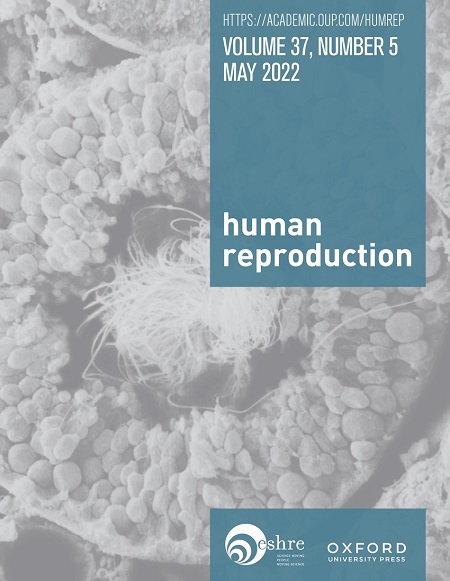Detection of minimal residual disease in cryopreserved testicular tissue from (pre)pubertal boys with acute leukemia following first-line therapy
IF 6
1区 医学
Q1 OBSTETRICS & GYNECOLOGY
引用次数: 0
Abstract
STUDY QUESTION Is it feasible to detect minimal residual disease (MRD) in cryopreserved testicular tissue (TT) from (pre)pubertal boys diagnosed with acute leukemia using molecular biology techniques? SUMMARY ANSWER This pilot study demonstrates the feasibility of detecting MRD in cryopreserved TT, which could guide the choice of the safest techniques for fertility restoration. WHAT IS KNOWN ALREADY Fertility preservation through testicular tissue freezing (TTF) is offered to (pre)pubertal boys undergoing highly gonadotoxic treatment. However, the risk of reintroducing leukemic cells during fertility restoration has not been adequately addressed. To date, no study has evaluated the feasibility of detecting residual disease using molecular biology within cryopreserved, thawed and unfixed TT. STUDY DESIGN, SIZE, DURATION This pilot study analyzed cryopreserved TT from 14 (pre)pubertal boys diagnosed with acute lymphoblastic leukemia (ALL) or acute myeloblastic leukemia (AML) who had already received first-line chemotherapy and underwent TTF before hematopoietic stem cell transplantation. PARTICIPANTS/MATERIALS, SETTING, METHODS The study included cryopreserved TT from 14 (pre)pubertal boys. Molecular biology techniques, including RT-qPCR and qPCR, were used to detect oncogenic fusion genes or clonal rearrangements of immunoglobulin genes or T-cell receptor (Ig/TCR) in cryopreserved TT samples. MAIN RESULTS AND THE ROLE OF CHANCE MRD was identified in 36% (5 out of 14) of TT samples using molecular biology techniques. A 21% discordance was observed between conventional histopathology and molecular detection, with molecular methods showing higher sensitivity. No significant association was found between clinical or histological characteristics and MRD status in the TT. LIMITATIONS, REASONS FOR CAUTION This study is a pilot study with a small sample size of TT samples from patients with ALL or AML, which may limit the generalizability of the findings. Further studies with larger cohorts are needed to validate our data. WIDER IMPLICATIONS OF THE FINDINGS The detection of MRD in cryopreserved TT using molecular biology techniques could help guide the selection of the safest fertility restoration strategies for leukemic patients by minimizing the risk of reintroducing malignant cells. This approach underscores the importance of cryopreserving TT after complete remission of acute leukemia (AL). STUDY FUNDING/COMPETING INTEREST(S) The study was funded by Rouen University Hospital, GIRCI NO, French Biomedicine Agency, and Ligue National Contre le Cancer. The authors declare no competing interests. TRIAL REGISTRATION NUMBER Not applicable.青春期前男孩急性白血病一线治疗后低温保存睾丸组织微量残留病变的检测
研究问题:用分子生物学技术检测青春期前诊断为急性白血病的男孩冷冻保存睾丸组织(TT)中的微小残留病变(MRD)是否可行?本初步研究证明了在冷冻保存的TT中检测MRD的可行性,这可以指导选择最安全的生育恢复技术。通过睾丸组织冷冻(TTF)保存生育能力是提供给(前)青春期男孩接受高度性腺毒素治疗。然而,在生育恢复过程中重新引入白血病细胞的风险尚未得到充分解决。迄今为止,还没有研究评估利用分子生物学检测冷冻、解冻和未固定TT中残留疾病的可行性。这项初步研究分析了14名青春期前诊断为急性淋巴细胞白血病(ALL)或急性髓母细胞白血病(AML)的男孩的冷冻TT,这些男孩在造血干细胞移植前已经接受了一线化疗并接受了TTF。参与者/材料,环境,方法本研究包括冷冻保存的14名青春期前男孩的TT。分子生物学技术,包括RT-qPCR和qPCR,用于检测冷冻保存的TT样品中致癌融合基因或免疫球蛋白基因或t细胞受体(Ig/TCR)的克隆重排。使用分子生物学技术,在36%(14个样品中的5个)的TT样品中确定了CHANCE MRD的作用。常规组织病理学和分子检测之间存在21%的差异,分子方法具有更高的灵敏度。在TT的临床或组织学特征与MRD状态之间没有发现显著的关联。这项研究是一项试点研究,样本量较小,来自ALL或AML患者的TT样本可能限制了研究结果的普遍性。需要更大规模的进一步研究来验证我们的数据。研究结果的更广泛意义使用分子生物学技术检测冷冻TT的MRD可以帮助指导白血病患者选择最安全的生育恢复策略,最大限度地减少恶性细胞重新引入的风险。这种方法强调了在急性白血病(AL)完全缓解后冷冻保存TT的重要性。研究经费/竞争利益(S)本研究由鲁昂大学医院、GIRCI NO、法国生物医药机构和法国国家癌症控制中心资助。作者声明没有利益冲突。试验注册号不适用。
本文章由计算机程序翻译,如有差异,请以英文原文为准。
求助全文
约1分钟内获得全文
求助全文
来源期刊

Human reproduction
医学-妇产科学
CiteScore
10.90
自引率
6.60%
发文量
1369
审稿时长
1 months
期刊介绍:
Human Reproduction features full-length, peer-reviewed papers reporting original research, concise clinical case reports, as well as opinions and debates on topical issues.
Papers published cover the clinical science and medical aspects of reproductive physiology, pathology and endocrinology; including andrology, gonad function, gametogenesis, fertilization, embryo development, implantation, early pregnancy, genetics, genetic diagnosis, oncology, infectious disease, surgery, contraception, infertility treatment, psychology, ethics and social issues.
 求助内容:
求助内容: 应助结果提醒方式:
应助结果提醒方式:


